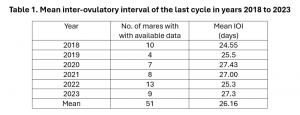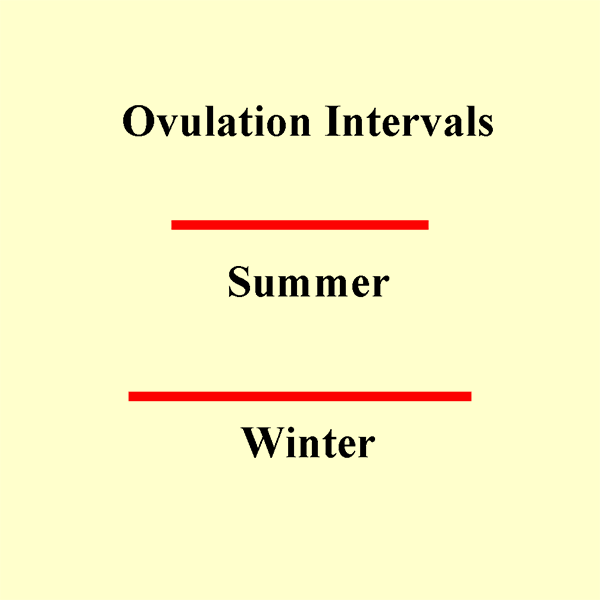The last completed cycle (IOI) of the year before a phase of extended winter anoestrus is significantly longer than the midsummer IOI in each mare
By Professor John Newcombe, BVetMed, MRCVS
Abstract
Data held at a Clinic at latitude 52°N was examined retrospectively to determine the length of the last Inter-ovulatory Interval (“IOI” – “cycle”) preceding a period of winter anoestrus in 6 years in mixed breed mares under ambient light conditions. This was compared with the mean Winter IOI in the same 16 individual mares in June and July. There was no difference between years. Winter IOI ranged from 24.5 to 27.3 days. Winter IOI were found to be a mean of 5.8 days longer than summer IOI with variation between mares of 1.3 to 9.2 days. Four mares (19%) remained cyclic throughout 11 of the 24 mare/winters. Twelve other mares became anoestrus in a total of 51 winters. Overall incidence of continued cyclicity was 11/86 (12.8%). Anoestrus began any month between September and March with 61% entering in November and December. Of those mares which remained cyclic, IOI were the same in summer as in October and November but became 6 days longer in December and January reducing in February and March. IOI were the same in January and February for both cyclic and potentially acyclic mares.
Introduction
The mare is polyoestrous[1] with a tendency to cycle all year but in the higher latitudes of both the northern and southern hemispheres, in response to variable seasonal day/night ratios, there is also a tendency to enter a period of winter anoestrus with absence of follicular activity. Cessation of ovulatory activity when this occurs, is also variable with the last ovulations occurring anytime between September and February. Those mares which cease ovulatory activity do not resume cyclicity again until April or May. The majority of mares cease ovulation in November and December but the few which continue to cycle, have extended inter-ovulatory intervals (IOI) which are especially significant in the late winter. Similarly, those which manage to cycle late into the winter before entering anoestrus, may also suffer extended IOI. Since many studies use comparison of mean IOI in the research, it is import that where mean IOI may be longer in winter than in spring/summer/autumn that this is accounted for in the analyses.
This retrospective study examines an extensive data base to look at the variability in the IOI between months, individual mares, mare age and between seasons (years)
Materials and Methods
A herd of mixed breed horse mares were maintained at the Clinic (52°N) under ambient conditions at pasture, supplemented as needed by hay/haylage. Body condition scores (BCS) were largely maintained from summer to winter but with some older mares losing scores of 1 to 2 (out of 10) between peak summer fatness and late winter.
During the so-called ‘autumn transition’ mares were examined with ultrasound, sufficiently frequently to determine the date of the last few cycles of the year and thus the IOI to within one day. The length of the last completed cycle (IOI) before phase of extended anoestrus was recorded. Data from the same mares of completed cycles examined at least once daily in June and July (mid-summer) was recorded. All IOI were spontaneous and not influenced any luteolytic or ovulatory preparations.
The data was examined retrospectively. 65 mare/years were found in 6 seasons (years) in the 16 mares which had been examined sufficiently regularly to accurately record the IOI during both summer and in the period up to the cessation of ovulatory activity. In the same individual mares, at least three completed IOI were recorded in June and July and at least two IOI before anoestrus.
Results
Table 1 shows the mean IOI before the last ovulation in each of the six years. This ranged from 24.55 days to 27.43 days with no significant variation between years. In 89 summer IOI (5.56 IOI/mare (range 3 to 8/mare), the mean IOI was 21.0 days with a significant range between individual mares of 18.2 to 25.3 days.
In 89 summer IOI (5.56 IOI/mare (range 3 to 8/mare), the mean IOI was 21.0 days with a significant range between individual mares of 18.2 to 25.3 days.
In 51 winter IOI (mean 3.75 IOI/mare, range 2 to 6/mare) the mean was 26.8 days (individual mare range 23.2 to 31.5 days) (Table 2) The difference between winter and summer mean IOI for all 16 mares was 5.8 days with a range between individuals from 1.3 to 9.2 days.
The difference between winter and summer mean IOI for all 16 mares was 5.8 days with a range between individuals from 1.3 to 9.2 days.
Just 4 individual mares of the 16 remained cyclic through to spring (19%) during 11 of 24 winters observed (46%). The 12 other mares plus 4 mares in the same group for which there was insufficient data to be included in the analysis (Table 2), entered an anoestrus phase during a total of 62 mare/winters. Thus the incidence of continued cyclicity was 11/86 (12.8%) in this population of mixed breeds under ambient conditions.
Mares entered a period of anoestrus in any month from September to March (Table 3) with 61% entering in either November or December
The mean IOI of those which remained cyclic is shown in Table 4. Normal IOI (20.7 days) were found in both October and November with the IOI not extended until December and January (26.7 and 26.1days respectively). In February and March, the IOI reduced towards the IOI seen in June and July.
Discussion
Studies involving comparison of inter-ovulatory intervals (cycle lengths) need to account for the range of variation between individual mares. Part of this variation may be a tendency for an either earlier or later luteolysis, thus reducing or extending the length of the luteal phase. However, most of the variation will be in the length of the follicular phase, that period between luteolysis and ovulation which could be short when a relatively large follicle is already developed at the end of the luteal phase, or conversely, longer when the mare is yet to develop an emerging follicle e.g.< 15mm. It is well recognised that when luteolysis is effected by prostaglandin administration, the subsequent interval to ovulation is highly dependent on the stage of development of the follicle present at the time. When a particular study is limited to the summer months, the variation between cycles in an individual may not be significant. However, this study demonstrates that comparisons of IOI involving summer and late season cycles, must take into account that there could be a considerable difference between May/June/July/August IOI and later intervals, since the majority of mares will cycle as late as November or December. This study, taken over 6 seasons, analyses the data available from 16 mares and 51 cycles, shows that while the IOI in these mares which cycle all winter does not significantly lengthen until December, the IOI of the last cycle in mares which enter an acyclic phase is already longer regardless of the month. Some 30 of the 62 (48%) mares which ceased cycling, did so from September to November.
It is of interest that the longest IOI in the four cyclic mares of 26.7 and 26.1 days in December and January respectively, was similar to the mean IOI of the last cycle in the acyclic mares. Two of these mares had 3 unusually long IOI of 48 and 45 days in January-March and one of 57 days between 13th March and 9th May with substantial periods of follicular inactivity between the time of luteolysis and the development of a follicle. Whether these should be regarded as cases of true winter anoestrus or unusually long ‘cycles’ is debatable. Table 4 analysis gives mean IOI with and without these three long IOI. Since none of the other mares which experienced a period of winter anoestrus cycled again until April or May with a mean date of April 23rd, the three instances of resumption of ovulation in March suggests that the latter were long IOI rather than short periods of winter anoestrus.
In those 4 mares with continued cyclicity, the IOI had reduced to less than 24 days, by February compared with 30.5 days (n=8) a month earlier. The three mares which ceased cycling in February had a similar mean IOI of 24.3 days compared with 31.1 days (n=11) for those mares which ceased in January. The close similarities in IOI in January and February between cyclic and potentially acyclic mare suggests there are factors which determine the ability to either continue or stop cycling other than the pituitary hormones which govern cyclicity.
Summary
The last completed cycle before a period of winter anoestrus is up to 9 days longer than cycles in mid-summer.
References:
1: Nagy P, Guillaume D, Daels P. 2000. Seasonality in mares. Animal Reproduction Science 60-61(Suppl.1):245-62.
© 2024 Professor John Newcombe, BVetMed, MRCVS



